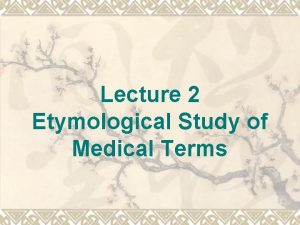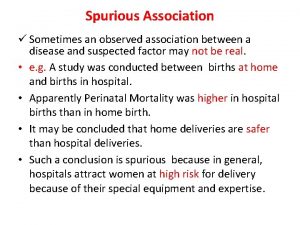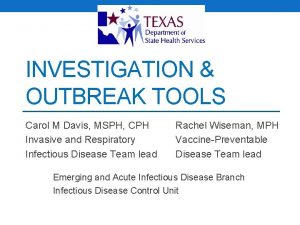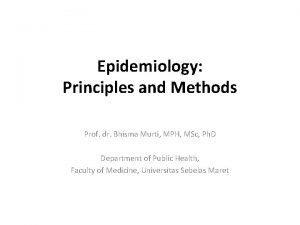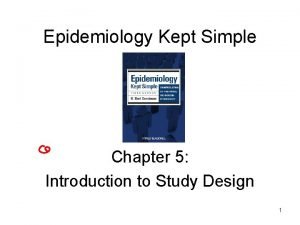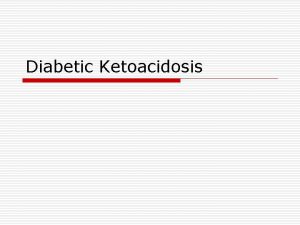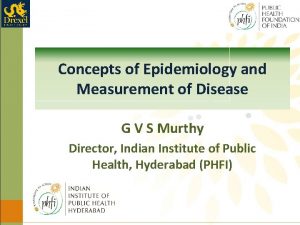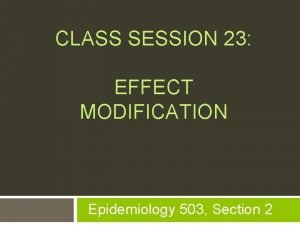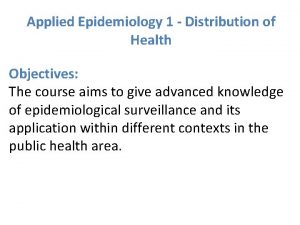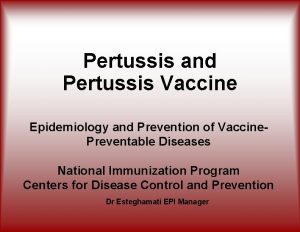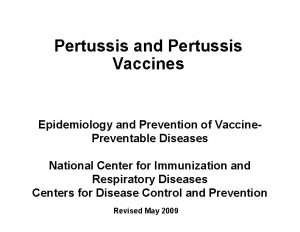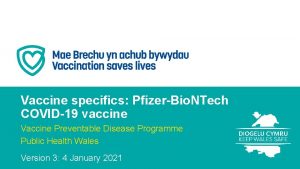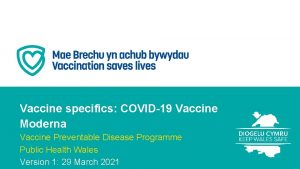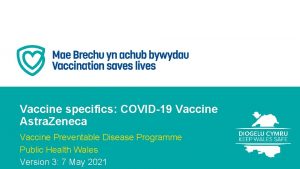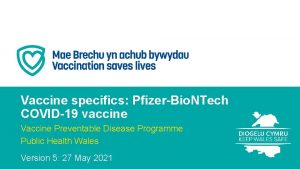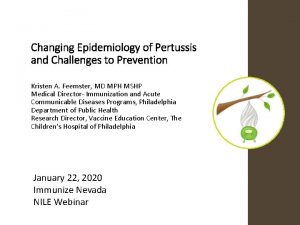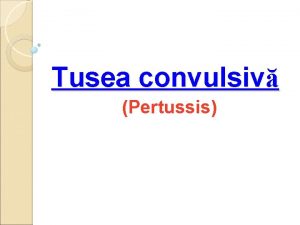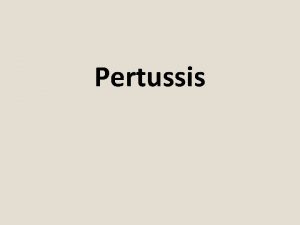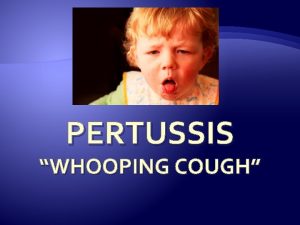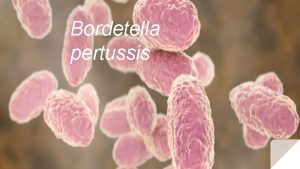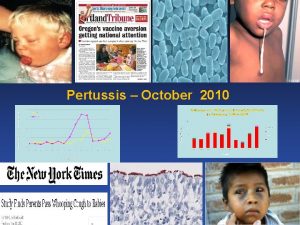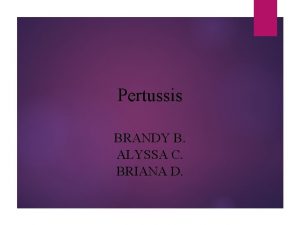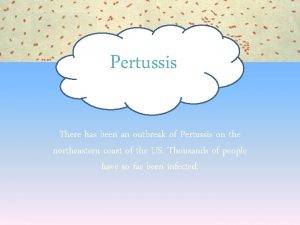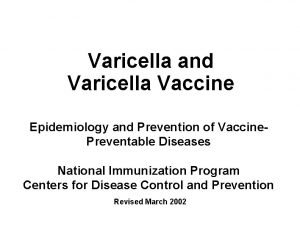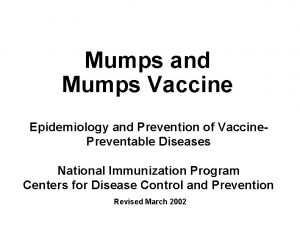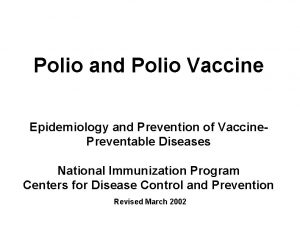Pertussis and Pertussis Vaccine Epidemiology and Prevention of
































- Slides: 32

Pertussis and Pertussis Vaccine Epidemiology and Prevention of Vaccine. Preventable Diseases National Immunization Program Centers for Disease Control and Prevention Revised August 2002

Pertussis • Highly contagious respiratory infection caused by Bordetella pertussis • Outbreaks first described in 16 th century • Bordetella pertussis isolated in 1906 • Estimated >300, 000 deaths annually worldwide

Bordetella pertussis • Fastidious gram negative bacteria • Antigenic and biologically active components: – pertussis toxin (PT) – filamentous hemagglutinin (FHA) – agglutinogens – adenylate cyclase – pertactin – tracheal cytotoxin

Pertussis Pathogenesis • Attachment to cilia of ciliated epithelial cells in respiratory tract • Pertussis antigens allow evasion of host defenses (lymphocytosis but impaired chemotaxis) • Local tissue damage in respiratory tract • Systemic disease may be toxin mediated

Pertussis Clinical Features • Incubation period 5 -10 days (up to 21 days) • Insidious onset, similar to minor upper respiratory infection with nonspecific cough • Fever usually minimal throughout course

Pertussis Clinical Features • Catarrhal stage 1 -2 weeks • Paroxysmal cough stage • Convalescence 1 -6 weeks Weeks to months

Pertussis in Adults • Accounts for up to 7% of cough illnesses per year • Disease often milder than in infants and children • Adults often source of infection for children

Pertussis Complications* Condition Percent reported Pneumonia 5. 2 Seizures 0. 8 Encephalopathy 0. 1 Death 0. 2 Hospitalization 20 *Cases reported to CDC 1997 -2000 (N=28, 187)

Pertussis Complications by Age *Cases reported to CDC 1997 -2000 (N=28, 187)

Pertussis Epidemiology • Reservoir Human Adolescents and adults • Transmission Respiratory droplets Airborne rare • Communicability Maximum in catarrhal stage Secondary attack rate up to 90%

Pertussis – United States, 1940 -2001* *2001 provisional data

Pertussis – United States, 1980 -2001* *2001 provisional data

Pertussis – United States, 1985 -2000 Age Distribution of Reported Cases

Whole Cell Pertussis Vaccine • Developed in mid-1930 s and combined as DTP in mid-1940 s • 70%-90% efficacy after 3 doses • Protection for 5 -10 years • Local adverse reactions common

Acellular Pertussis Vaccine (DTa. P) • Purified "subunit" vaccines • Intended to reduce adverse reactions • Licensed for fourth and fifth doses in 1991 • Licensed for full series in 1996

Composition* of Acellular Pertussis Vaccines Product PT DAPTACEL 10 FHA PERT FIM 5 3 5 Infanrix 25 25 8 -- Tripedia 23 23 -- -- *mcg per dose

DTa. P Clinical Trials Product Location VE (95% CI) Infanrix Italy 84% (76 -89) Tripedia Germany 80% (59 -90) DAPTACEL Sweden 85% (80 -89)

Routine DTa. P Primary Vaccination Schedule Dose Primary 1 Primary 2 Primary 3 Primary 4 Age 2 months 4 months 6 months 15 -18 months Interval --4 wks 6 mos

DTa. P Fourth Dose • Recommended at 15 -18 months • May be given at 12 months of age if: – child is 12 months of age, and – 6 months since DTa. P 3, and – unlikely to return at 15 -18 months

School Entry (fifth) Dose • Fifth dose recommended when 4 th dose given before age 4 years • Only Tripedia currently licensed for 5 th dose after DTa. P series

Interchangeability of Different Brands of DTa. P Vaccine • No efficacy or safety data available for "mix-and-match" DTa. P schedules • Series should be completed with same brand of vaccine • Use different brand of DTa. P if necessary

DTa. P-Hib Combination Vaccine • Do not use for primary immunization at 2, 4, or 6 months of age • May be used as the booster dose of the Hib series at >12 months of age following any Hib vaccine* *booster dose should follow prior dose by >2 months

Pertussis Vaccine Use in Children with Underlying Neurologic Disorders Underlying Condition Recommendation Prior seizure Delay and assess* Suspected neurologic disorder Delay and assess* Neurologic event between doses Delay and assess* Stable/resolved neurologic condition Vaccinate *vaccinate after treatment initiated and condition stabilized

Pertussis Vaccination of Children Who Have Recovered From Pertussis • If documented disease, do not need additional doses of pertussis vaccine • Satisfactory documentation of disease: – recovery of B. pertussis on culture, OR – typical symptoms and clinical course when epidemiologically linked to a culture- proven case

Pertussis Vaccine in Adults • No pertussis vaccine licensed for use in adults in the United States • Acellular pertussis vaccine safe and immunogenic in adults • Impact on disease or transmission unknown • Not routinely recommended at this time

DTa. P Adverse Reactions • Local reactions • Low grade fever • More severe adverse reactions uncommon • Local reactions more common following 4 th and 5 th doses

Adverse Reactions Following the 4 th and 5 th DTa. P Dose • Local adverse reactions and fever increased with 4 th and 5 th doses of DTa. P • Reports of swelling of entire limb • Extensive swelling after 4 th dose NOT a contraindication to 5 th dose

Adverse Events Reported Following 1 st and 4 th DTa. P

DTa. P Contraindications • Serious allergic reaction to component or following prior dose • Encephalopathy occurring within 7 days after vaccination not due to another identifiable cause

DTa. P Precautions (Warnings)* • Moderate or severe acute illness • Temperature >105 F (40. 5 C) or higher within 48 hours with no other identifiable cause • Collapse or shock-like state (hypotonichyporesponsive episode) within 48 hours • Persistent, inconsolable crying lasting >3 hours, occurring within 48 hours • Convulsions with or without fever occurring within 3 days *may consider use in outbreaks

DTa. P Substitution • DTa. P should NOT be substituted in children who have a valid contraindication to whole cell pertussis vaccine • DT should be used to complete the series

National Immunization Program • Hotline 800. 232. 2522 • Email nipinfo@cdc. gov • Website www. cdc. gov/nip
 Primary prevention secondary prevention tertiary prevention
Primary prevention secondary prevention tertiary prevention Coinage
Coinage Difference between descriptive and analytical epidemiology
Difference between descriptive and analytical epidemiology Nutrition epidemiology definition
Nutrition epidemiology definition Descriptive vs analytical epidemiology
Descriptive vs analytical epidemiology Descriptive vs analytic epidemiology examples
Descriptive vs analytic epidemiology examples Cbic recertification
Cbic recertification Person place and time model in epidemiology
Person place and time model in epidemiology Perbedaan relative risk dan odds ratio
Perbedaan relative risk dan odds ratio Logistic regression epidemiology
Logistic regression epidemiology Prevalence rate formula
Prevalence rate formula Descriptive vs analytic epidemiology examples
Descriptive vs analytic epidemiology examples Attack rate calculation
Attack rate calculation Pros and cons of cross sectional study
Pros and cons of cross sectional study Recall bias example
Recall bias example Attack rate calculation
Attack rate calculation Gate frame epidemiology
Gate frame epidemiology Wheel model of disease causation example
Wheel model of disease causation example Epidemiology defination
Epidemiology defination Defination of epidemiology
Defination of epidemiology Concept of epidemiology
Concept of epidemiology What is descriptive study in epidemiology
What is descriptive study in epidemiology Spurious association
Spurious association Field epidemiology ppt
Field epidemiology ppt Aims of epidemiology
Aims of epidemiology Gordon nichols
Gordon nichols Epidemiology kept simple
Epidemiology kept simple Diabetic ketoacidosis epidemiology
Diabetic ketoacidosis epidemiology Distribution in epidemiology
Distribution in epidemiology Effect modification vs confounding
Effect modification vs confounding Distribution in epidemiology
Distribution in epidemiology Ramboman
Ramboman Epidemiology definition
Epidemiology definition

